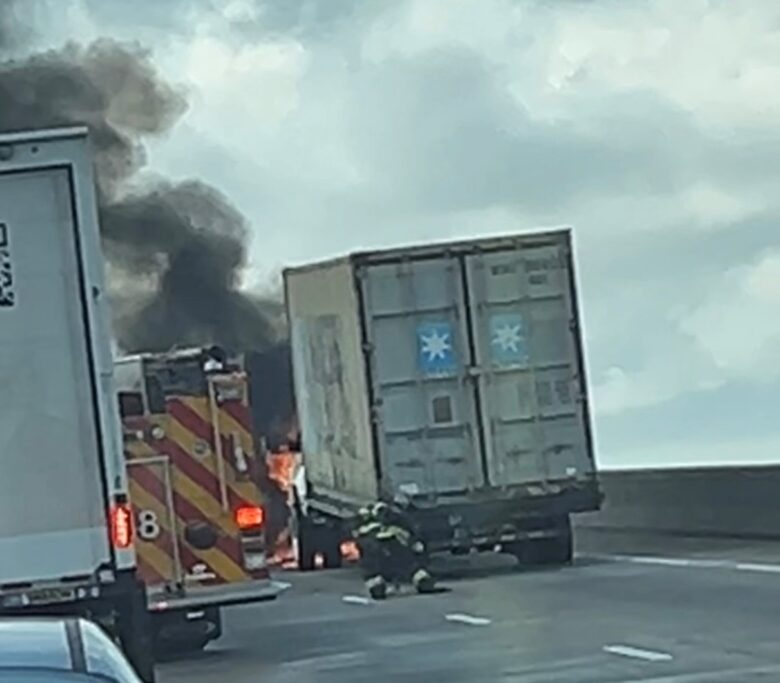Overview:
A 2020 Chevy Silverado 3500 Duramax diesel hauling an empty 20’ container mysteriously caught fire today on the westbound side of the 526 bridge. Our video of the blaze is live on YouTube—but what caused it? We dig into two possible culprits: aftermarket modifications commonly made to Duramax trucks or Charleston’s notorious sea-salt corrosion problem. This isn’t the first roadside inferno, and probably won’t be the last.
A Bridge, a Blaze, and a Burning Question
Today, Charleston commuters watched in shock as thick black smoke billowed into the sky from the 526 bridge heading westbound toward Mount Pleasant. A 2020 Chevy Silverado 3500 HD—fully lifted, fitted with 19.5” Alcoa rims, and hauling a 20-foot storage container—erupted into flames mid-transit.
Presence News obtained and published exclusive video footage of the incident, captured just moments after the truck pulled to the side of the bridge. While emergency crews quickly shut down one lane and ensured no injuries occurred, the cause of the blaze remains a mystery—at least officially.
But locals know: this isn’t an isolated event.
Charleston is no stranger to roadside fires. Ask any local mechanic, and they’ll tell you fires like this happen weekly. Is there a bigger story here? We think so.
We dug into two distinct—and potentially conspiratorial—culprits behind today’s fire. Here’s what we found.
Scenario 1: Aftermarket Modifications + DEF System Failures
This truck wasn’t your average factory-fresh Silverado. It was lifted 3 inches, ran 19.5” Alcoa wheels (a heavy-duty trucker favorite), and was used in hotshot trucking—hauling light, fast freight like today’s empty container from Charleston’s rail line to its shipyard.
While diesel trucks are known for their power, Duramax’s 6.6L engine in models after 2019 has a reputation—and not a good one.
These engines are infamous for DEF (Diesel Exhaust Fluid) sensor issues. The sensors are part of a federal emissions system that’s supposed to clean up diesel output. In theory, they help the environment. In practice, they break constantly. Worse, they’re often on national backorder, forcing truckers into desperate measures.
When a DEF sensor goes out, the truck can go into “limp mode,” limiting its power to a crawl. For owner-operators with deadlines, this isn’t just inconvenient—it’s career-killing. That’s why many disable the DEF system entirely, removing the sensors or using aftermarket software to bypass them.
Enter the conspiracy.
Some truck owners report that modifying or deleting DEF systems has unintended consequences, especially when paired with cheap or off-brand aftermarket parts. Poor installation, faulty programming, and mismatched hardware can result in overheating, electrical faults, and spontaneous fires.
Could this be what happened on the 526?
Did a heat-soaked, overloaded diesel truck with a bypassed DEF system and modified components finally reach its breaking point?
We may never know exactly what was done under the hood, but sources say trucks like these are a ticking time bomb—and Charleston’s traffic patterns might just be the ignition.
Scenario 2: Salt Air—Charleston’s Silent Killer
Let’s go deeper.
If you live in the Lowcountry, you’ve likely heard someone blame the salty air for… well, everything. Rust, failing electronics, mysterious corrosion—it’s the cost of living near the water. But is there any truth to this?
Absolutely.
Charleston sits just a few feet above sea level. The salty Atlantic breeze carries corrosive particles miles inland every day. Combined with high humidity and constant heat, it’s a perfect storm for rapid metal decay.
Especially in vehicles.
Metal brake lines, fuel components, wire sheathing—they don’t stand a chance. Even newer trucks start showing signs of rust and wear within 18 months if not frequently cleaned and maintained.
And with no real public warning system, most drivers are unaware just how fast their undercarriage is turning to dust.
Multiple local mechanics confirmed to Presence News that salt-related corrosion is now one of the leading causes of spontaneous vehicle fires in the Charleston metro area. “If it’s not a battery short, it’s a brake line or fuel return line rusting out and popping under heat,” said one shop owner who requested anonymity.
So let’s ask the real question: Is Charleston ignoring its salty secret?
With one truck fire a week, where’s the city-wide prevention plan? No undercarriage rinse mandates, No awareness campaign, No real inspections. It’s a slow burn waiting to turn into a blaze.
The Bigger Picture
Whether it was the aftermath of DEF system mods or the creeping rust of salt exposure, one thing is clear: this truck didn’t catch fire by accident.
Charleston’s roads have become a battleground of modern diesel tech, sea air sabotage, and invisible risks. Every week, locals pass burned-out husks on the shoulder like ghost stories on repeat.
And each time, no real answers are given. No news conferences. No investigations. Just another fire, another tow truck, and another insurance claim.
Could it be that industry lobbyists and local government are ignoring the scale of the problem? Are automakers refusing to address poor DEF sensor design because of the cost of a recall? Or has everyone just gotten used to the smoke?
It’s time for the public to ask tougher questions.
Watch It for Yourself
You can watch the full video of the truck fire on our YouTube channel [Presence News]. While we made sure not to show the driver or any identifying info, the scene speaks for itself.
This wasn’t just a fire. It was a warning.
Can you write a better article? if you can WE PAY VENMO CASHAPP STRAIGHT TO YOU email us your writer creds to editor@presencenews.org
